All of San Giovanni in Fiore seemed to be driving down Via Gramsci as I searched out the atelier of Calabrian textile artist Domenico Caruso. I was looking forward to the encounter as I had admired photos of his extraordinary work for quite some time. And wouldn’t you know, the old carpet hanging in front of his shop distinguished the location perfectly: Caruso Tessiture Artistiche & Scuola Tappeti. I sought out a parking spot and as I was about to ring the bell, a friendly face popped out of an upstairs window. He would be right down.
DOMENICO CARUSO
Shortly cropped hair and a rather full beard framed a warm smile and penetrating gaze. Strongly connected to his roots, Domenico Caruso was born and raised in San Giovanni in Fiore, a population center of Calabria’s Sila Mountains. An image of his father hung on the wall facing his desk, like a family photo but an intricate tapestry. One of his four children entered as we were talking. The young boy greeted me politely and continued on his way. Upstairs, there was a child-sized loom the master textile artist had built for his children.
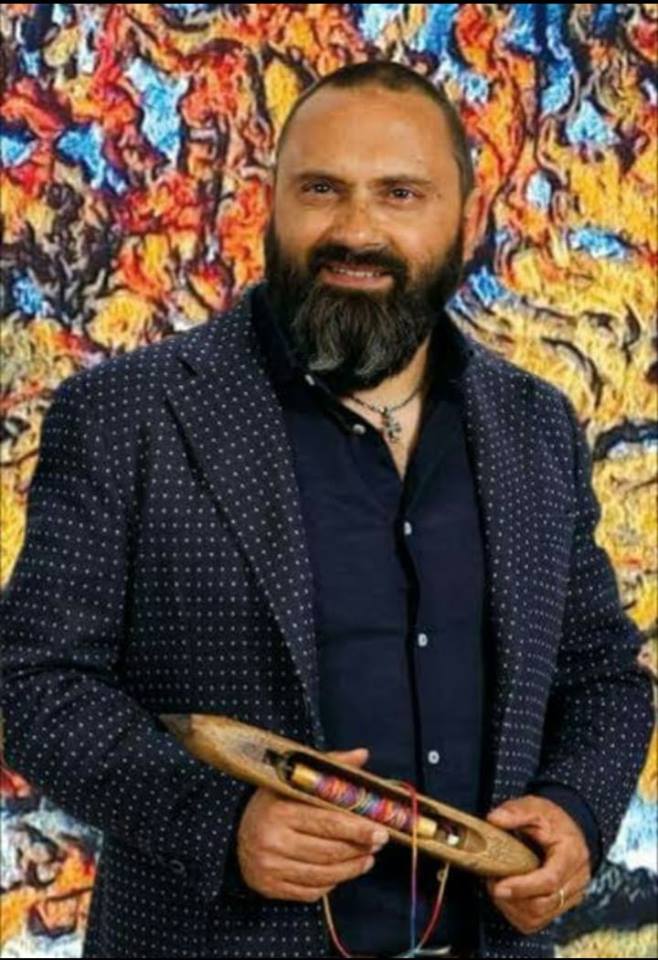
Domenico Caruso (photo courtesy of D. Caruso)
The whole family enthusiastically embraces the weaving activities. His lovely wife, Francesca Bisceglia, also works in the business, which not only produces unique textiles in a vast array of materials and styles but also repairs and cleans older, damaged articles.
Domenico Caruso is exceedingly precise, warm and unpretentious. He is the first (and to date, only) textile artist to have created a piece of cloth completely in gold thread, both weft and warp, for which he devised a new apparatus. Top designers have sought out his fabrics for their haute couture, his woven masterpieces have garnered international acclaim, and he may also be seen personally giftwrapping a client’s modest purchase. Caruso puts his all into everything he does.
TEXTILE HISTORY OF SAN GIOVANNI IN FIORE

Antique loom at Caruso Tessiture Artistiche, San Giovanni in Fiore
On my visit to his studio, Domenico Caruso narrated the history of textiles in the area, an 800-year tradition connected with the abbey that was founded by Gioacchino da Fiore or Joachim of Flora (c. 1135-1202), Calabrian theologian and medieval prophet. The Florense Abbey began as a hermitage and subsequently served as a refuge, offering hospitality and political asylum for families fleeing from the surrounding territories of Crotone and Cosenza. The people cultivated the land and raised animals, and to protect themselves from the cold temperatures of the mountainous region, became proficient weavers. Every family had a loom, and the area was particularly noted for its bedspreads and garments.
The Florense Abbey eventually gave rise to the town of San Giovanni in Fiore. Over time, the textiles were influenced by the many different cultures that passed through the territory. There was a give and take of style and ideas, such as Greek, Arab, Spanish and French. Interestingly, it wasn’t until the 20th century that the local textile production expanded to include rug making.
In the 1920s Armenians began to arrive in San Giovanni in Fiore. They were textile workers who brought their craft with them, and after World War II, the Scuola Tappeti or Carpet School was founded. The Armenian rug makers taught local women how to knot rugs. The school was active from 1952 to 1978, when the Armenians left the area.
THE CARUSO FAMILY
Salvatore Caruso, Domenico’s father, continued the work of the carpet school in San Giovanni in Fiore. He was already in the textile business and came from a family with a long history in the field. Under his direction, the school continued working with the Armenian designs.
Domenico showed a keen interest in textiles at an early age and studied at the Accademia di Belle Arti (Fine Arts Academy) in Catanzaro. He felt that maintaining his roots was important but at the same time he had the desire to branch out in other directions. And today, Caruso Tessiture Artistiche produces hand-woven textiles with historic and classic motifs as well as fabrics, tapestries and carpets with contemporary and original designs.
CLASSIC WOVEN TEXTILES
On my visit, a work in progress on an antique loom in the corner of the shop beautifully illustrated one of the classic designs from the area, the punto del guidice or judge’s stitch. The pattern is characterized by a saw-tooth rhombus shape, the jagged edges of which are meant to represent clear-cut justice. Two doves, symbolizing purity, perch on vine branches, connected to show a union and balanced to illustrate equitability under the law. At the center of the design, life’s constant is represented by an image of the pine, a symbol of existence and support for the people of the Sila mountains.

The “Pinto del Giudice” pattern
At the shop entrance, a bedroom nook displayed a classic flowered bedspread over which hung a garden-scene tapestry.

Classic bedspread and tapestry by Caruso Tessiture Artistiche, San Giovanni in Fiore
Old sewing tables were piled with skeins of thread in the vast array of materials used to create the great variety of textiles: cotton, wool, linen, silk, and even Scotch broom, once a common raw material, but now only on request due to the cost of today’s manual labor to produce thread from the ginestra plant. Another table was full of old tools of the trade.
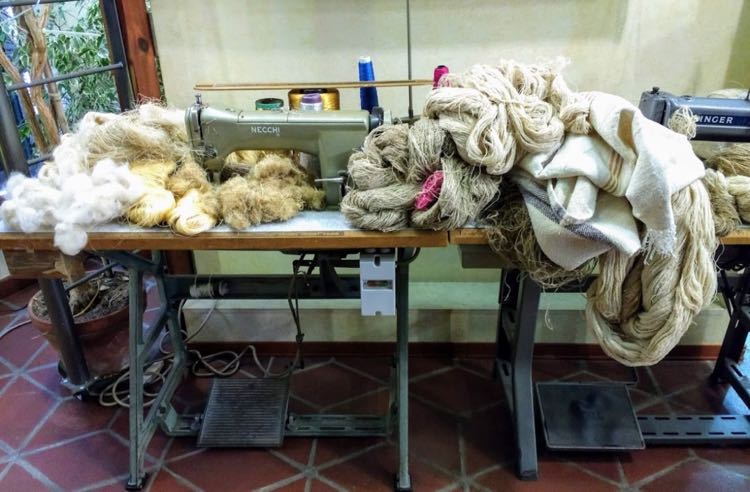
Workshop, Caruso Tessiture Artistiche in San Giovanni in Fiore
Blankets and bedspreads, antique and of antique design were stacked on shelves around the shop. Bathroom, kitchen and dining linens were also on display. Each and every item I saw was crafted by hand, row per row of fine weaves.

Shelves of hand-woven textiles at Caruso Tessiture Artistiche
Carpets could be flipped through as they hung in exhibition or appraised in a pile on the floor. The artisans in San Giovanni in Fiore are busy people. About twenty work on old looms in their homes around town, mostly women, some of whom were already working for Domenico’s father when he was a young boy. Today, the maestro, himself, focuses on design and special projects; the wheels in his head are always turning.
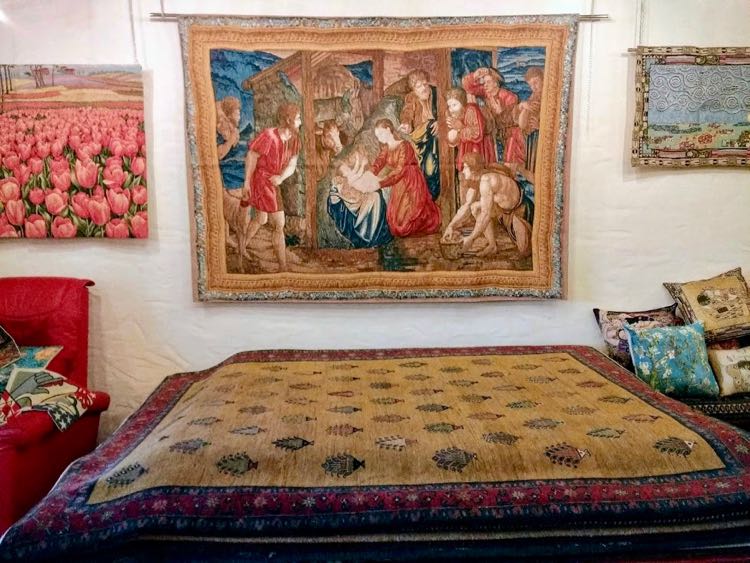
Carpets and tapestries for sale, Caruso Tessiture Artistiche
CARUSO TESSITURE ARTISTICHE– CARUSO ARTISTIC WOVEN TEXTILES
With his solid foundation, from familial and cultural roots to the mastery of classic weaving to a formal study of the arts, Domenico Caruso continues to embrace tradition while striving to innovate. So in addition to the timeless, historical patterns, Caruso Tessiture Artistiche features images and designs from more recent centuries as well as new creations.
His tapestry based on Edgar Degas’ pastel “Blue Dancers” is a fine example of his talent and finesse. Even from fairly close up, the thought, “Is it a painting?” cannot help but flash through one’s mind. The rich, pictorial depiction in the Gobelin style was executed on a Jacquard loom, an apparatus with perforated cards to facilitate the production of complicated images. Interestingly, Caruso noted that the Jacquard loom was invented by a Calabrian, who had been sent from Catanzaro to Paris at the request of the King of Naples between the end of the 17th and the beginning of the 18th century.

“Blue Dancers” of Edgar Degas, Tapestry by Domenico Caruso Tessiture Artistiche, San Giovanni in Fiore
His homage to the Italian singer Mina is truly a masterpiece: two and a half million knots in pure silk that recreate an image from the booklet of her album Ti conosco mascherina. (By the way, if you haven’t ever heard Mina, listen to her singing “Brava,” and you won’t believe your ears.)
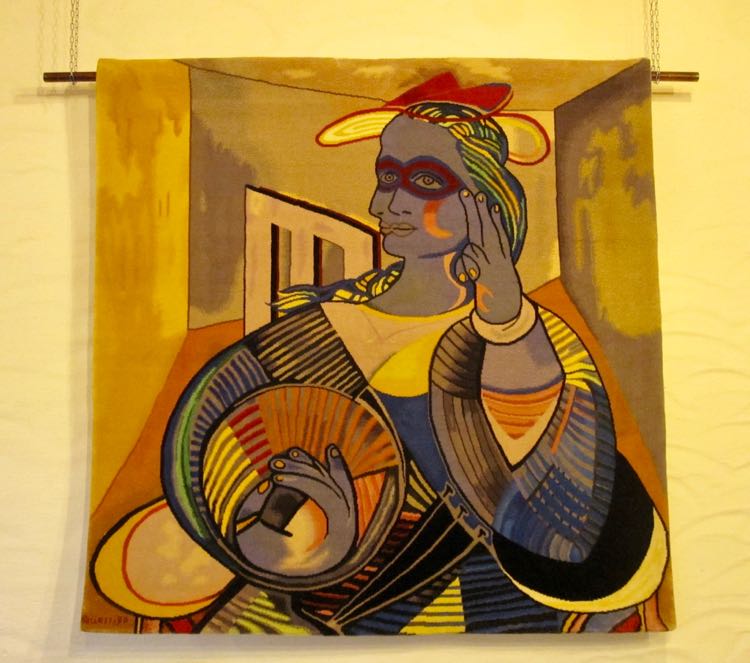
“Mina” Tapestry by Domenico Caruso Tessiture Artistiche, San Giovanni in Fiore
In his intriguing tapestry VibranteNudoRelaxBlu Caruso plays with optical illusion in an image completely of his own design.

VibranteNudoRelaxBlu, handmade tapestry, 93 x 130 cm by Caruso Tessiture Artistiche (Photo courtesy of D. Caruso)
INSPIRATION FROM JOACHIM OF FLORA
The citizens of San Giovanni in Fiore are proud of Gioacchino da Fiore; and growing up in this town founded by the abbot, Domenico Caruso couldn’t help but have been inspired by the theologian, in particular, by the fantastical images of the Liber figurarum. In this “Book of Figures,” Joachim expressed his ecclesiastical vision with flowering trees, circles symbolically linked together, a seven-headed dragon and other creative designs rather modern for the period. In fact, Caruso considers Joachim of Flora to be the father of abstract art.
The master weaver’s reproductions of Joachim’s images in large, silk tapestries, completely knotted by hand, each consuming well over a year’s labor, are magnificent. Pope John Paul II happily received Caruso’s donation of intertwined circles representing the trinity for the Vatican museums. Look closely at this photo. This is the pure silk tapestry. Amazing.
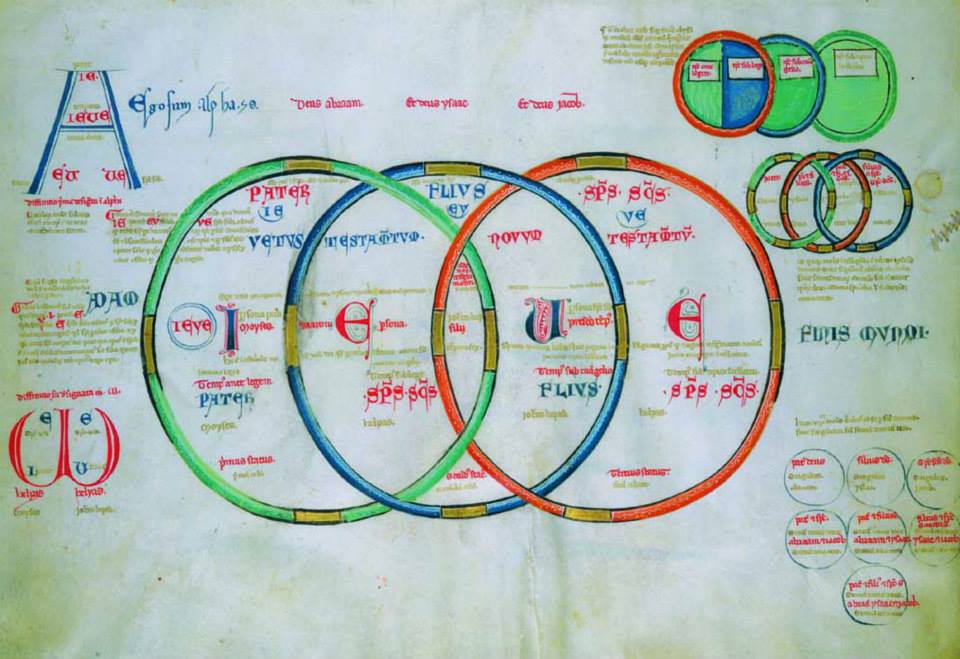
Trinity Circles from Joachim of Flora’s Liber figurarum, silk tapestry by Domenico Caruso, 200 x 140 cm (photo courtesy of D. Caruso)
UNIQUE TEXTILES BY CARUSO TESSITURE ARTISTICHE
At this point, the reader, no doubt, is thinking that a Caruso original is way out of his league. Certainly, a sizable tapestry which may take a year and a half to complete would be destined for a museum or the walls of the rich and famous. However, Caruso has something for everyone, from table runners and linens to accent pillow covers and shawls. A surprising collection of articles for sale are available in his locations in San Giovanni in Fiore, Cosenza, and on-line. He takes commissions, as well.
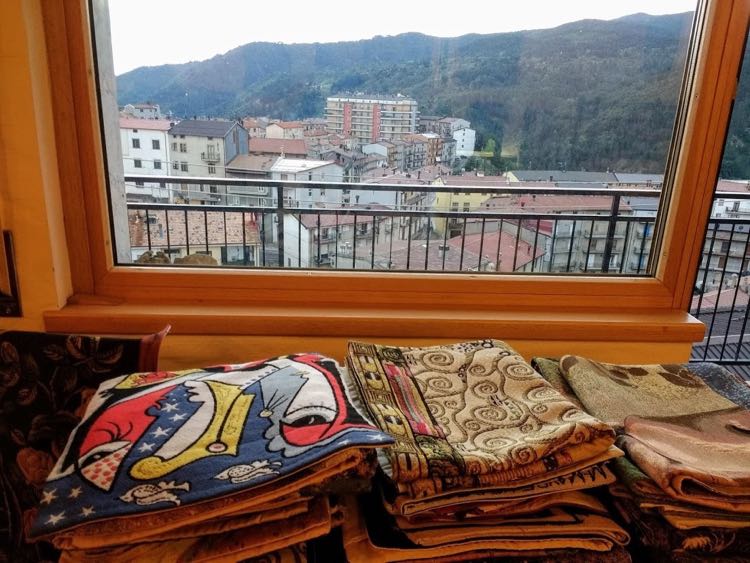
View from shop window in San Giovanni in Fiore
A few years ago, Caruso began making purses with his hand-woven fabrics, and these artisan handbags have taken off. Patterns range from classic florals to reproductions of artistic masterworks to renditions of the designs by Joachim of Flora. Teaming with a leather craftsman, Caruso also produces larger bags and backpacks finished with fine French leather and fashioned for the cultured businessman or the casually elegant woman on the go. (Perfect for an American travel writer and blogger leading a Calabria tour?)

Handmade bags by Caruso Tessiture Artistiche, San Giovanni in Fiore
A couple of very pleasant hours flew by on my visit to Caruso Tessiture Artistiche & Scuola Tappeti. I thought, “How many knots could Domenico have tied in that time?” And, “What a satisfaction it must be for him to be able to spend his life doing something he loves.” Of course, in order to make a living and employ others in a region that so many must leave to find a job, he not only uses his artistic skills, but his imagination for business, as well. And then I looked around at the meticulous work put into each and every beautiful piece, images formed by hand, line by line, not stamped on a machine, each one unique. Priceless.

Tapestry of the Madonna del Pilerio in progress, Caruso Tessiture Artistiche (photo courtesy of D. Caruso)
Visit Caruso Tessiture Artistiche & Scuola Tappeti in San Giovanni in Fiore on my Traditions and Food of Calabria Tour!
Happen to find yourself in the historic center of Cosenza? Drop by Caruso’s shop at Corso Telesio 69. In San Giovanni in Fiore? Stop by Via A. Gramsci 195. And follow the master textile artist on Facebook at Caruso Tessiture Artistiche & Scuola Tappeti.
Related posts on this blog: San Giovanni in Fiore: Gioacchino’s Outpost in the Sila Mountains, Lanificio Leo Textile Factory: Blending Tradition and Innovation in Calabria, The Ceramics of Seminara, Calabria – In the Studio of Enzo Ferraro and Eco-Printing and a Day in the Caulonia Countryside.
 Read more about the fascinating region in the toe of the boot in Calabria: The Other Italy, my non-fiction book about daily life, history, culture, art, food and society in this important area of South Italy. It’s available in paperback and e-book versions.
Read more about the fascinating region in the toe of the boot in Calabria: The Other Italy, my non-fiction book about daily life, history, culture, art, food and society in this important area of South Italy. It’s available in paperback and e-book versions.
Connect on social media: “Like” Calabria: The Other Italy’s Facebook page, follow me on Karen’s Instagram and Karen’s Twitter for more beautiful pictures and information. Or join me on a small-group Calabria Tour!
Sign up below to receive the next blog post directly to your email for free.
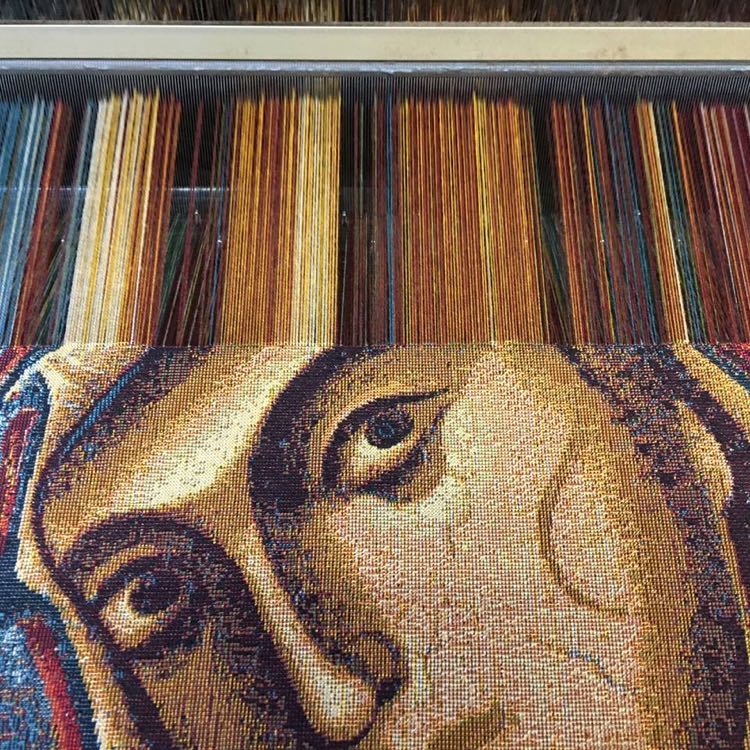
Comments 14
Very interesting. They sound like a great couple. Lovely blog. X
Author
Thanks. Yes, they are very nice people who work well together, which is always good to see.
Great story Karen on Mr Caruso thank you for sharing. I have a large wood carving made from a rare Calabrian wood called Tiglio, in my home from a well known Calabrian/Canadian artist Antonio Caruso. It is titled La Porta Del Paradiso. He is over 70 now. I have to wonder if they are related.
Frank Trecroci
Author
Interesting, it’s a common name but perhaps the artistic talent shares a familial thread. Glad you enjoyed this Caruso, too.
Wow, really amazing craftsmanship! Such a range of what they can produce! Enjoyed reading about it and getting to see some examples of what they can do!
Author
The variety is incredible. And then I look at a tapestry that is so beautifully executed and I learn that over a million knots were tied to achieve such precision, it’s a little mind-blowing.
I think we saw the studio on our first trip to Calabria probably 10 years ago. Our airbnb host took us there. ( Alfredo Granato) I think. I remember wanting everything in the shop!
Author
Yes, I can imagine. And now they’ve added handbags to the collection, so you’ll have to go back!
I love stories like these! I love seeing young Calabrians bring life back to important and beautiful traditions like these. My great-grandmother had a loom, she was one of the women in the town to go to when you needed something made. I also would love to visit San Giovanni in Fiore, it looks like a lovely town!
Author
San Giovanni in Fiore has so much history, and the tradition has continued as people like Domenico Caruso have adapted to the changes in the world around them. Brides no longer have trousseaus but women (and even men) have handbags, and usually more than one!
Wow this is amazing Karen! i have always wanted a loom, but i have too many arts on the go already! The Blue Dancers are even more beautiful than the painting. it is so wonderful that Signor Caruso’s children are learning the craft too. This is a priceless gift. i can see the Armenian/Byzantine like influence on some of the pieces, especially the Madonna in progress. Where did all the Armenians go? Ciao,Cristina
Author
The photo of the Madonna in progress is a tapestry of a 17th-century icon of the Madonna del Pilerio in the Cosenza Cathedral. This Madonna is the patron saint of Cosenza and is of Greek Orthodox origin. The Armenians only arrived in the 20th century and remained for 50+ years. I don’t know where they went but I can only imagine that they either returned to their homeland or moved on to other places more profitable. You do have a lot of art projects going on already so I’m not sure you want to take on a new one that might take a whole year to complete!
I love the runner I purchased from Signor Caruso’s textile shop! It is exquisitely made with a unique fringe on the ends. It gives me great pleasure to display it. His shop is filled with one-of-a-kind treasures!
Author
Great to hear, Judy – so nice to have the lovely piece combined with good memories.